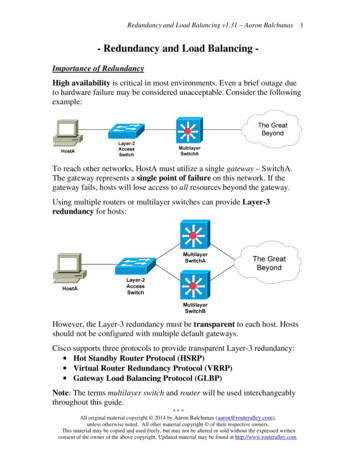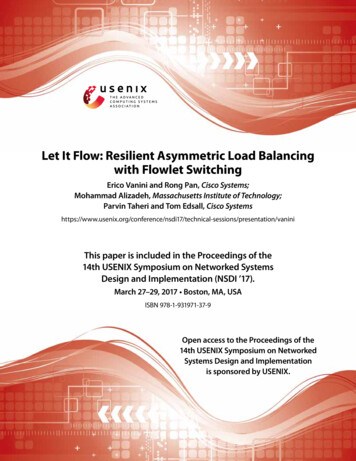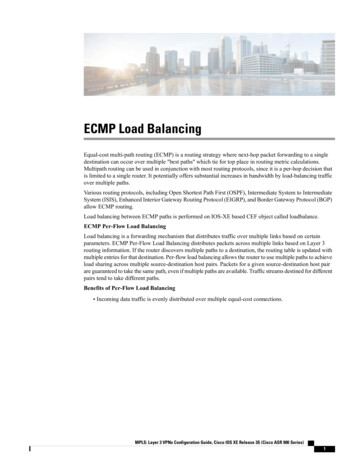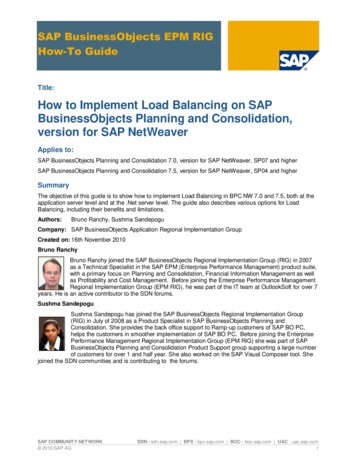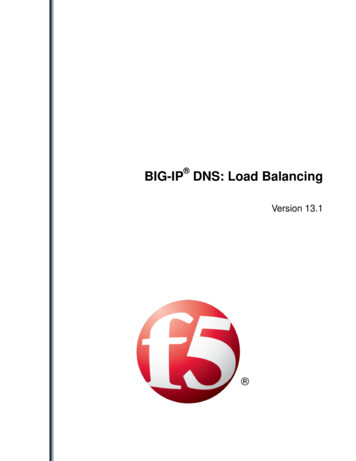
Transcription
BIG-IP DNS: Load BalancingVersion 13.1
Table of ContentsTable of ContentsAbout Global Server Load Balancing. 5Introducing BIG-IP DNS. 5About global server load balancing. 5Static load balancing methods. 5Dynamic load balancing methods. 7About load balancing and resource availability. 9About virtual server dependency.9Configuring virtual server availability to be dependent on the status of othervirtual servers.9Limit settings for resource availability.10About wide IP-level load balancing. 10About the Global Availability load balancing method.10About the Ratio load balancing method. 11About the Round Robin load balancing method.12About pool-level load balancing. 12About the Drop Packet load balancing method. 12About the Virtual Server Score load balancing method. 12About the Virtual Server Capacity load balancing method.13About the Round Trip Times load balancing method.13About the Packet Rate load balancing method. 13About the Least Connections load balancing method. 13About the Kilobyte/Second load balancing method.13About the Hops load balancing method. 13About the Completion Rate load balancing method. 13About the CPU load balancing method. 13About the Return to DNS load balancing method. 14About Static Persist load balancing. 14About the Fallback IP load balancing method. 14About the None load balancing method. 14About the QoS load balancing method.15About dynamic ratio load balancing. 17Using the preferred load balancing method when metrics are unavailable. 17Configuring the resources in a pool for manual resume.18Restoring availability of a pool member manually. 18Best Practices: Dynamic load balancing and performance configuration. 19Using Topology Load Balancing to Distribute DNS Requests to Specific Resources.21How do I configure BIG-IP DNS to load balance DNS requests to specificresources?. 21About Topology load balancing. 21Understanding topology records. 21Understanding how the BIG-IP system prioritizes topology records. 22Creating a topology record. 24Deleting a topology record. 24About Topology load balancing for a wide IP. 25Example configuration: Topology load balancing for a wide IP. 25Configuring a wide IP for Topology load balancing. 27About Topology load balancing for a pool. 28Example configuration: Topology load balancing for a pool. 283
Table of ContentsConfiguring a pool for Topology load balancing. 30About Topology load balancing for both wide IPs and pools.30About Topology load balancing for CNAME wide IPs and pools.31About IP geolocation data. 31About topology records and IP geolocation data.31Downloading and installing updates to the IP geolocation data. 31Reloading default geolocation data using the Configuration utility. 32Reloading default geolocation data using tmsh.32Preparing BIG-IP DNS for Static Persist Load Balancing for Transaction-OrientedTraffic. 35About Static Persist load balancing.35About configuring BIG-IP DNS to provide Static Persist load balancing . 35Configuring CIDR options for Static Persist load balancing. 35Legal Notices. 37Legal notices. 374
About Global Server Load BalancingIntroducing BIG-IP DNSBIG-IP DNS (formerly GTM ) is a system that monitors the availability and performance of globalresources and uses that information to manage network traffic patterns. BIG-IP DNS uses load balancingalgorithms, topology-based routing, and iRules to control and distribute traffic according to specificpolicies.About global server load balancingBIG-IP DNS provides tiered global server load balancing (GSLB). BIG-IP DNS distributes DNS nameresolution requests, first to the best available pool in a wide IP, and then to the best available virtualserver within that pool. BIG-IP DNS selects the best available resource using either a static or a dynamicload balancing method. Using a static load balancing method, BIG-IP DNS selects a resource based on apre-defined pattern. Using a dynamic load balancing method, BIG-IP DNS selects a resource based oncurrent performance metrics collected by the big3d agents running in each data center.Static load balancing methodsThis table describes the static load balancing methods available in BIG-IP DNS.NameDescriptionRecommended Use Wide IP PreferreLoaddBalancin IP DNS drops the DNSrequest.Use Drop Packet forNothe Alternate loadbalancing methodwhen you want toensure that BIG-IPDNS does not offer ina response a virtualserver that ispotentially unavailable.YesYesYesUse Fallback IP forNothe fallback loadbalancing methodwhen you want BIG-IPDNS to return adisaster recovery sitewhen the preferred andalternate loadbalancing methods donot return an availablevirtual server.NoNoYesFallback IP BIG-IP DNS distributes DNS nameresolution requests to a virtualserver that you specify. This virtualserver is not monitored foravailability.
About Global Server Load Balancing6NameDescriptionRecommended Use Wide IP PreferreLoaddBalancin lityBIG-IP DNS distributes DNS nameresolution requests to the firstavailable virtual server in a pool.BIG-IP DNS starts at the top of amanually configured list of virtualservers and sends requests to thefirst available virtual server in thelist. Only when the virtual serverbecomes unavailable does BIG-IPDNS send requests to the nextvirtual server in the list. Over time,the first virtual server in the listreceives the most requests and thelast virtual server in the list receivesthe least requests.Use GlobalYesAvailability when youhave specific virtualservers that you wantto handle most of therequests.YesYesYesNoneBIG-IP DNS distributes DNS nameresolution requests skipping eitherthe next available pool in a multiplepool configuration or the currentload balancing method. If all poolsare unavailable, BIG-IP DNSreturns an aggregate of the IPaddresses of all the virtual servers inthe pool using BIND.Use None for theNoalternate and fallbackmethods when youwant to limit each poolto a single loadbalancing method. Ifthe preferred loadbalancing method fails,BIG-IP DNS offers thenext pool in a loadbalancing response.NoYesYesRatioBIG-IP DNS distributes DNS nameresolution requests among thevirtual servers in a pool or amongpools in a multiple poolconfiguration using weighted roundrobin, a load balancing pattern inwhich requests are distributedamong several resources based on apriority level or weight assigned toeach resource.Use Ratio when youwant to send twice asmany connections to afast server and half asmany connections to aslow server.YesYesYesYesReturn toDNSBIG-IP DNS immediatelyUse Return to DNSNodistributes DNS name resolutionwhen you want torequests to an LDNS for resolution. temporarily remove apool from service. Youcan also use Return toDNS when you want tolimit a pool in a singlepool configuration toonly one or two loadbalancing attempts.YesYesYesRoundRobinBIG-IP DNS distributes DNS name Use Round Robinresolution requests in a circular and when you want tosequential pattern among the virtual distribute requestsYesYesYesYes
BIG-IP DNS: Load BalancingNameDescriptionRecommended Use Wide IP PreferreLoaddBalancin MethodgAlternateMethodFallbackMethodservers in a pool. Over time eachvirtual server receives an equalnumber of requests.equally among allvirtual servers in apool.StaticPersistBIG-IP DNS distributes DNS nameresolution requests to the firstavailable virtual server in a poolusing the persist mask with thesource IP address of the LDNS anda hash algorithm to determine theorder of the virtual servers in thelist. This hash algorithm orders thevirtual servers in the list differentlyfor each LDNS that is passingtraffic to the system taking intoaccount the specified CIDR of theLDNS. Each LDNS (and thus eachclient) generally resolves to thesame virtual server; however, whenthe selected virtual server becomesunavailable, BIG-IP DNS sendsrequests to another virtual serveruntil the original virtual serverbecomes available. Then BIG-IPDNS again resolves requests to thatvirtual server.Use Static Persistwhen you wantrequests from aspecific LDNS toresolve to a specificvirtual server.NoYesYesYesTopologyBIG-IP DNS distributes DNS nameresolution requests using proximitybased load balancing. BIG-IP DNSdetermines the proximity of theresource by comparing locationinformation derived from the DNSmessage to the topology records in atopology statement you haveconfigured.Use Topology whenyou want to sendrequests from a clientin a particulargeographic region to adata center or serverlocated in that region.YesYesYesYesDynamic load balancing methodsThis table describes the dynamic load balancing methods available in BIG-IP DNS.NameDescriptionWide ackmethodCompletion RateBIG-IP DNS distributes DNS name resolutionrequests to the virtual server that currentlymaintains the least number of dropped or timedout packets during a transaction between a datacenter and the client's LDNS.NoNoYesYes7
About Global Server Load hodCPUBIG-IP DNS distributes DNS name resolutionNorequests to the virtual server that currently has themost CPU processing time available.YesNoYesHopsBIG-IP DNS distributes DNS name resolutionNorequests to a virtual server in the data center thathas the fewest router hops from the client'sLDNS. BIG-IP DNS uses the traceroute utility totrack the number of router hops between a client'sLDNS and each data center.YesNoYesNoYesNoYesLeast Connections BIG-IP DNS distributes DNS name resolutionNorequests to virtual servers on BIG-IP LocalTraffic Manager (LTM ) that currently hosts thefewest connections. Use Least Connections onlywith LTM servers.YesNoYesPacket RateNoYesYesYesQuality of Service BIG-IP DNS distributes DNS name resolutionrequests to virtual servers based on a scoreassigned to each virtual server that is calculatedfrom current performance metrics. Use Qualityof Service only when you have configured BIGIP DNS to calculate an overall score for eachvirtual server based on performance metrics.NoYesNoYesRound Trip TimeBIG-IP DNS distributes DNS name resolutionrequests to the virtual server with the fastestmeasured round trip time between a data centerand a client's LDNS.NoYesNoYesVirtual ServerScoreBIG-IP DNS distributes DNS name resolutionrequests to virtual servers on LTM based on auser-defined ranki
About Global Server Load Balancing Introducing BIG-IP DNS BIG-IP DNS (formerly GTM ) is a system that monitors the availability and performance of global resources and uses that information to manage network traffic patterns. BIG-IP DNS uses load balancing




